
The new small sized automatic transaxle (A4CF1) is for Gamma 1.6 gasoline engine. The transaxle (A4CF1) is improved on the durability, fuel consumption and efficiency by the new main features as followed. The new main features 1. The hydraulic centrifugal oil pressure balance piston. 2. The full line pressure variable control system. 3. The long travel damper clutch. 4. The disc type return spring. 5. The ultra flat torque converter. |
Item | Contents |
Components | The full line pressure variable control operates in the valve body to improve the fuel consumption. |
The long travel damper clutch is applied to the torque converter to improve the engine revolution change reduction capability and the fuel consumption. (17~20°) | |
The oil pump of the trochocentric type is changed to parachoid type to improve the processing and the capacity efficiency at the low RPM range. | |
The disc type return spring is applied to the low&reverse brake to improve the durability and reduce the length. | |
The hydraulic centrifugal oil pressure balance piston is applied to the inside of clutch to improve the durability and the shift control capability. | |
The low noise gear and the gear teeth face grinding are applied to the transfer driven gear to improve the noise and the durability. | |
Electronic control system | The oil pressure value set by TCM is coupled with the engine torque so that the stable shift feeling can be improved. |
The engine torque reduction control operates effectively to improve the shift feeling and the durability. | |
It can be the skip shift of 1↔3 and 2↔4 when shifting. | |
The reverse clutch, not L/R brake is controlled when controlling the N→R shift so that the N→R shift feeling can be improved. | |
The range of the damper clutch direct control expands to improve the fuel consumption. | |
The current control chip is installed into the TCM to regulate the solenoid control current and control the oil pressure securely according to the change of the temperature and voltage. | |
The FPC(Flexible Printed Circuit) harness is composed of the thin and flat copper in the insulating film like electric wire. | |
The tachometer is operated by the change of the frequency forwarded from the TCM to the instrument cluster, not vehicle speed sensor. |
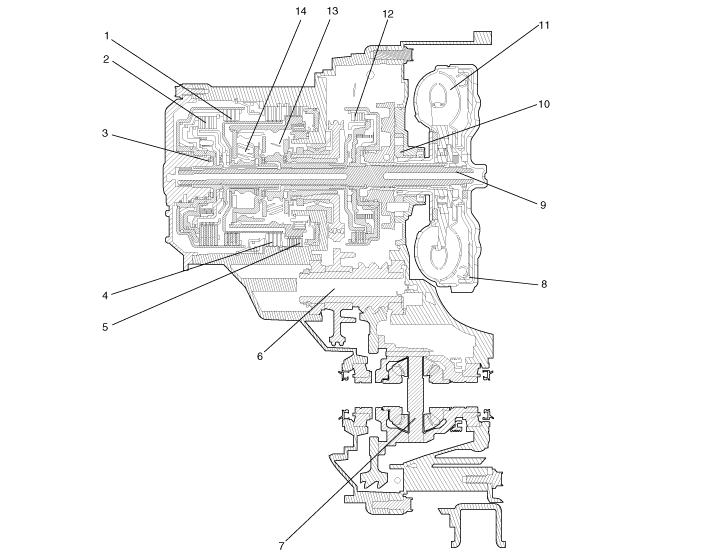
1. Reverse clutch 2. Overdrive clutch 3. Rear cover 4. Second brake 5. Low and reverse brake 6. Output shaft 7. Differential | 8. Damper clutch 9. Input shaft 10. Oil pump assembly 11. Torque converter assembly 12. Underdrive clutch 13. Output planetary carrier 14. Overdrive planetary carrier |
The torque converter, as the power plant which delivers the power of engine to the automatic transaxle, consists of 3 elements, 2 phases and 1 stage type. - The flowing section form of the torque converter changes the round type to the flat type to reduce the length of the torque converter. - The maximum operating degree of the damper clutch installed inside the transaxle increases from 11° to 18° to improve the engine revolution change reduction capability and the fuel consumption. |
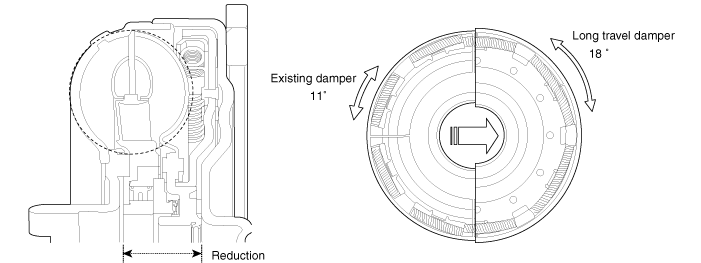
The oil pump is made of the aluminum (the reaction shaft support) to loose the weight and selects the parachoid type to improve the processing and the capacity efficiency at the low RPM range. |
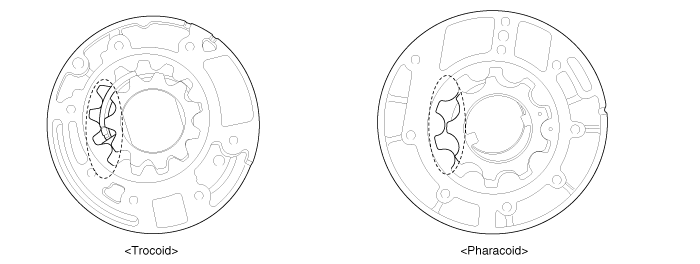
The automatic transaxle (A4CF1) uses the low and reverse brake and the second brake. The low and reverse brake is fixed by the low and reverse annulus gear and overdrive planetary carrier. - The disc type return spring is applied to the low and reverse brake and it minimizes the slip of the friction material from the uniform spring operation power to improve the durability and reduce the length. The reverse sun gear is held on the transaxle case by the second brake. |


The multiple clutches and the one way clutch are used as the transaxle device. The retainer of each clutch is composed of the precision sheet metal parts to realize the productivity and the light weight. The hydraulic centrifugal oil pressure balance device places inside the clutch assembly. Generally the oil remained in the piston oil pressure chamber pushes the piston by the centrifugal force. But to prevent the piston from being pushed, the oil filled in between the piston and the return spring retainer occurs the centrifugal force and both of the power is offset so that the piston don't move. In result, it improves the durability and the shift control ability. |

The driving force of input shaft is delivered to the underdrive sun gear. The operating oil pressure in the underdrive clutch components operates between the piston and the retainer and pushes the piston to the clutch discs to deliver the driving force from the retainer to the hub. |
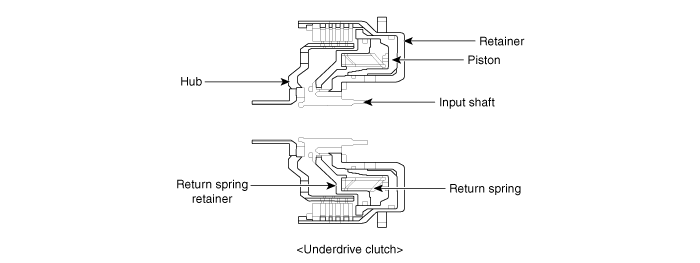
The reverse clutch delivers the driving force of input shaft to the reverse sun gear. The overdrive clutch delivers the driving force of input shaft to the overdrive planetary carrier and the low and reverse annulus gear. The operating oil pressure of the reverse clutch operates between the reverse clutch retainer and reverse clutch piston and it has the whole overdrive clutch moved through hub splines. |
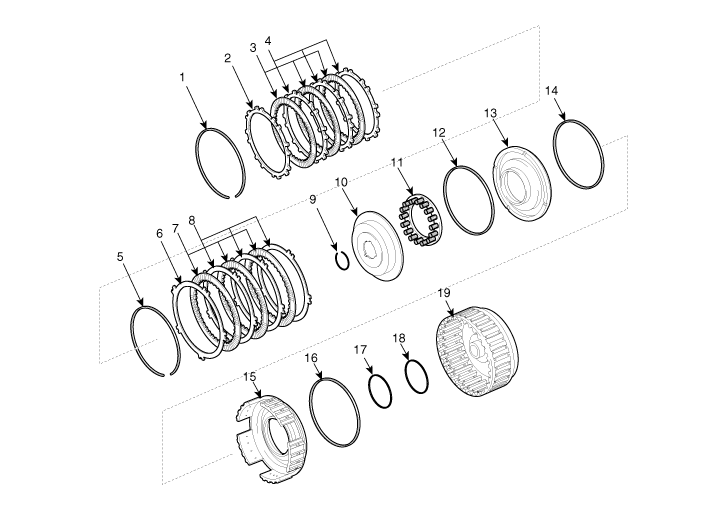
1. Snap ring 2. Clutch reaction plate 3. Clutch disc 4. Clutch plate 5. Snap ring 6. Clutch reaction plate 7. Clutch disc | 8. Clutch plate 9. Snap ring 10. Spring retainer 11. Return spring 12. D-ring 13. Overdrive clutch piston 14. D-ring | 15. Reverse clutch piston 16. D-ring 17. D-ring 18. D-ring 19. Reverse clutch retainer |
The parking system for A4CF1 model is the cam type.
The roller type installed to the existing new generation AT needs the support to move the roller when operating the parking system and is so complicated. But the cam type for A4CF1 model doesn't need the support and the structure is simply. It only needs the guide to prevent from moving the cam idly.

Main Features
The VFS (Variable Force Solenoid) installed in the valve body is applied to transaxle. VFS varies the line pressure from 4.5bar to 10.5bar according to throttle open angle and shift range to improve the fuel consumption and shift ability.
The reducing valve installed in the valve body makes the solenoid control pressure using the reducing pressure instead of the line pressure like the HIVEC transaxle.
The material of spool valve in the valve body is changed from the steel to aluminum to reduce the oil leakage by the thermal expansion between the valve body and spool valve at the high temperature.
The switch valve, the solenoid valve and the fail safe valve are operated to drive the vehicle at 3rd speed and reverse even if an electronic control parts malfunction occurs.
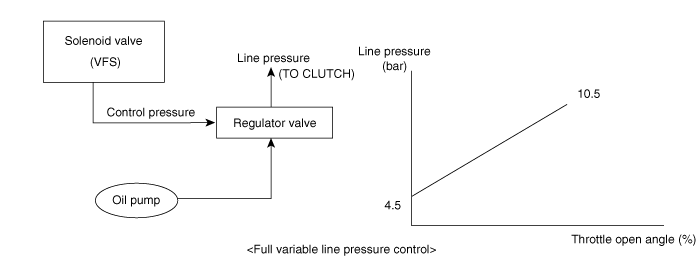
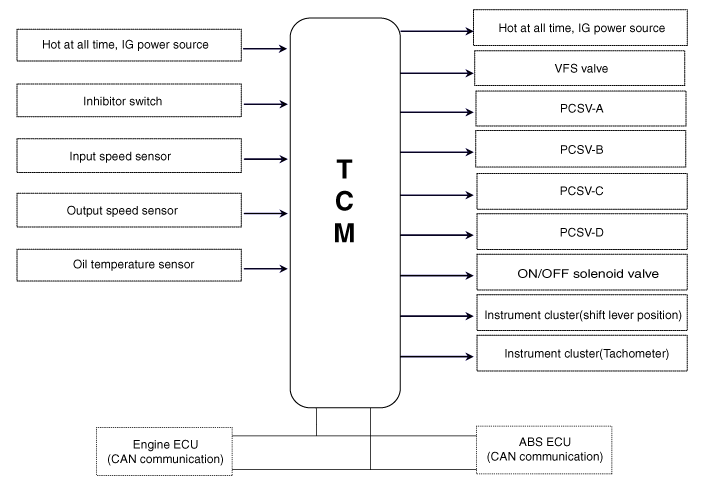
Item | Function |
Input speed sensor | Detect the input shaft rpm(TURBINE RPM) at the OD/RVS retainer |
Output speed sensor | Detect the output shaft rpm(T/F DRIVEN GEAR RPM) at the T/F driven gear |
Engine rpm signal | Receive the engine rpm via CAN communication with ECM |
Fluid temperature sensor | Detect the temperature of ATF through the thermistor |
Brake switch | Detect the brake operation at the contact switch of the brake pedal |
ON/OFF solenoid valve (SCSV-A) | Control the hydraulic passage for the shift control |
VFS solenoid valve | Change the line pressure from 4.5 bar to 10.5 bar according to throttle open angle and shift ranges |
PCSV-A(SCSV-B) | Control the OD or L/R hydraulic pressure to the pressure control valve for shift control |
PCSV-B(SCSV-C) | Control the 2/4 or REV hydraulic pressure to the pressure control valve for shift control |
PCSV-C(SCSV-D) | Control the UD hydraulic pressure to the pressure control valve for shift control |
PCSV-D(DCCV) | Control the hydraulic pressure for the damper clutch control |
Cluster | Send the signal of the current position of shift lever and vehicle speed |

No. | Item | Error management |
1 | Engine rpm | 3,000 RPM |
2 | Engine torque | 80% |
3 | Vehicle speed | 0 km/h |
4 | A/C Switch | OFF |
5 | Engine coolant temperature | 70°C |
6 | TPS | 50% |
7 | Shift range hold signal | OFF |